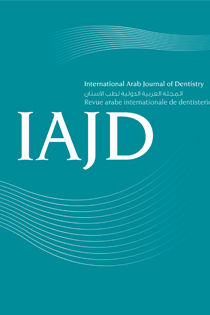Abstract
The aims of the present study were 1) to assess the prevalence of periodontal disease (PD) in a population of young people with type 1 diabetes in Lebanon; 2) to compare it to a nondiabetic control group; 3) to perform blood test of interleukin 6 (IL-6) for cases and controls and 4) to compare the results with the
literature and analyze the potential links between these two pathologies. A screening of the pocket depth (PD) by clinical examination of the entire mouth was performed in patients between 12 and 25 years, with a mean plaque index less than or equal to 1, with type 1 diabetes for more than 5 years, attending the Chronic
Care Center (CCC). The control group comprised non-diabetics, meeting the same criteria of age and sex and attending the dental care center at the Faculty of Dental Medicine, SaintJoseph University of Beirut for non-periodontal treatments. The number of decayed, missing, filled teeth (DMF), periodontal pocket depth (PD), clinical attachment loss (CAL), gingival recession (RG), bleeding on probing (BOP) and the Community Periodontal Index of Treatment Needs (CPITN) were screened. The presence of moderate or severe periodontitis was defined by the criteria of Page & Eke [1]. Socio-demographic and personal data of the patients, as well as their oral hygiene habits, the history of diabetes, glycemic control, complications and treatment of diabetes, were collected from patient records;
a standardized questionnaire was filled by the participants as well. A blood test was performed to evaluate the IL-6 among cases and controls. Eighty-three diabetic patients and 93 controls were included in our study. The prevalence of PD was 45.7% for moderate and 14.4% for severe forms in diabetic patients, and 0% in
controls. This study showed that the duration of diabetes, age, sex, socioeconomic level, and social status did not influence the periodontal status. However, in uncontrolled diabetes, deep pockets were significantly greater. There was no statistically significant difference between the CAO averages in the two groups. Finally, the rate of IL-6 was significantly higher in diabetics compared to healthy subjects and was greater in the presence of periodontal disease. The prevalence of PD in young type 1 diabetic patients treated at CCC is relatively high and comparable to the literature. A centralized multidisciplinary management and strict control
of the risk factors may contribute in controlling this disease. The inflammatory mediators such as IL-6 may constitute a potential link between these two diseases and remains to be assessed more accurately in prospective studies.

